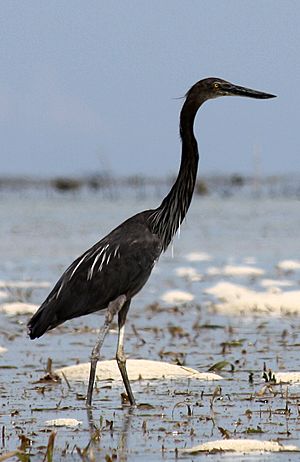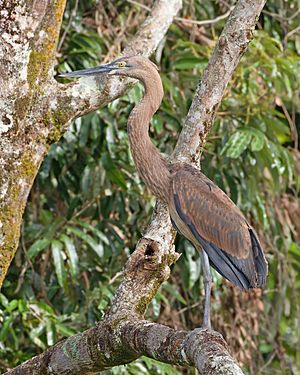Great-billed Heron facts for kids
Quick facts for kids Great-billed Heron |
|
|---|---|
 |
|
| Adult in Palawan, Philippines | |
| Conservation status | |
| Scientific classification | |
| Kingdom: | |
| Phylum: | |
| Class: | |
| Order: | |
| Family: | |
| Genus: |
Ardea
|
| Species: |
A. sumatrana
|
| Binomial name | |
| Ardea sumatrana Raffles, 1822
|
|
The Great-billed Heron (Ardea sumatrana) is a large wading bird that belongs to the heron family, called Ardeidae. These amazing birds live in places from southeast Asia all the way to Papua New Guinea and Australia.
Great-billed Herons are skilled hunters. They like to feed in shallow water, using their long, sharp bills to catch fish. They can either wait very still for their prey to come close or slowly sneak up on their next meal.
About the Great-billed Heron
The Great-billed Heron is a truly big bird! It usually stands about 115 centimeters (45 inches) tall. That's almost as tall as some kids! It can weigh up to 2.6 kilograms (5.7 pounds).
This heron has mostly dark grey feathers on its body. When it flies, its upper wings also look a uniform dark grey. It looks a bit like the purple heron, but the Great-billed Heron is larger and has darker feathers.
How It Flies
When a Great-billed Heron flies, it moves slowly and pulls its neck back. This is a special way of flying that herons and bitterns do. It helps you tell them apart from other large birds like storks, cranes, and spoonbills, which fly with their necks stretched out.
Where It Lives
The Great-billed Heron lives across a very wide area! You can find them in many coastal parts of Southern Asia and Australasia. This includes countries like Australia, India, Indonesia, Malaysia, and the Philippines.
These herons mostly live near the coast. They love places like islands, coral reefs, mangrove forests, and big rivers. Sometimes, you might even spot them further inland in shallow ponds.
See also
 In Spanish: Garza de Sumatra para niños
In Spanish: Garza de Sumatra para niños



